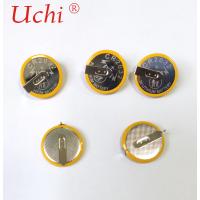Uchi was established in 2006 in Dongguan, China.
After years of development, Uchi has become a large scale hi-tech
enterprise that specialized in development and production of
complete series of MOV,PTC, NTC series, PPTC series, Fuse(ALL
TYPE),Resistor、integrated circuit 、 Capacitor, surge protector and
protective devices of lightning protection products. It ranks front
in the industry and has heartquarter in Hong Kong. With its
excellent technology and quality products, Uchi has won wide
recognition of overseas customers. Saini Impex PVT.LTD is our
authorized sole distributor in india .
China's leading enterprise of circuit protection components
Our strength :
A large number of product series in our factory have passed the
certification of various international standards
Factory Tour :
Advanced equipment, lean production
Uchi boasts with a production base that covers an area of nearly
15000 square meters.
We successively imported high-tech fully automated production
equipments and high precision testing instruments and have put into
production to realize the automation, large scale and
standardization.
Uchi has a galaxy of hi-tech talent teams headed up by national
class experts to engage in the work of product development, product
quality control, sales andservice technical support, etc., and has
successively obtained tens of certificates of appearance patents,
utility patents and inventions.
To guarantee the quality, we successfully passed the certification
of ISO9001:2008 quality management system, scientific and efficient
managing mode to carry out lean production and form scientific and
efficient quality control system. The products are certified with
UL, CUL, TUV, VDE, CSA and SGS, RACH 73 environmentally friendly
testing certifications.
Exquisite quality at customers' favor
Uchi is an export membership of Alibaba with free import and export
rights. It is appraised as Guangdong Famous Star Enterprise and
Dongguan Private Enterprise. Our products have doubled and
redoubled to provide more kinds and high quality and reliable
products and service. Our products mainly consist of:
Metal Oxide Varistor
DIP Varistor & SMD Varistor
Thermally Protected Varistor
DC-Link Capacitor for New energy vehicles supporting the HEVEV
Automotive Fuse Links for EV Plugin HEV FCEV
PTC Thermistor
NTC Thermistor
PPTC Resettable Fuse
Thermal Fuse
Auto Blade Fuse
Glass Fuses
Metal Film Resistor
Carbon Film Resistor
Cement Resistor
NTC Temperature Sensor
CDS Photoconductive Cell
Our products are widely used in New energy vehicles, home appliance, medical equipment, office equipment, communication
equipment, phone battery, electronic calendar, electronic
thermometer and temperature controller to cover military
telecommunications, IT, automobile and consumer electronic fields.
Cooperation with good faiths to win in the market.
Excellent quality sincere service is the key to the success of
Uchi.
In the future Uchi will still stick to the tenets of "Quality
first, customer foremost." "First class quality, first class
service and customersatisfaction" to manufacture the high quality,
technically advanced and reasonable prices products. We hope to
trigger with global partners the revolution in resistor products.
We cordially welcome friends from home and abroad to visit us for
guidance and cooperation.











